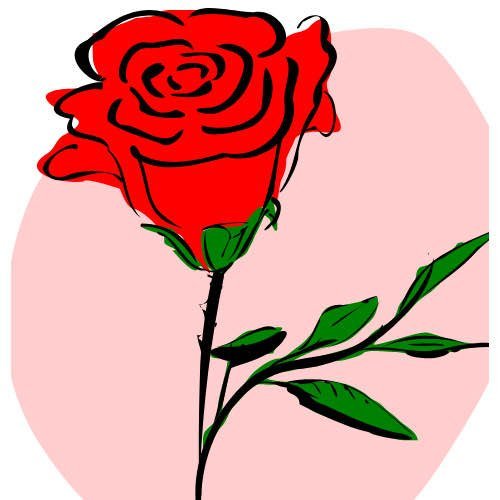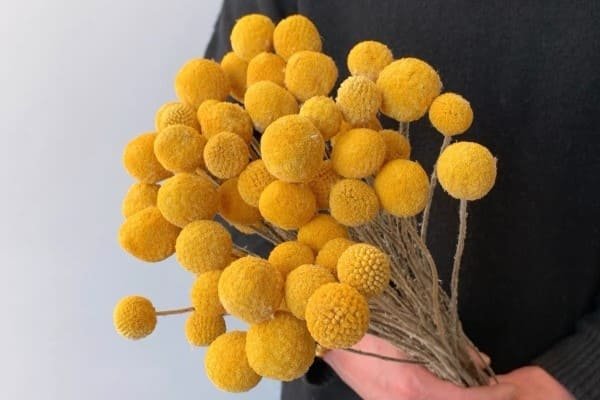


Dried Craspedia, also known as billy balls or billy buttons, is a standout flower in the world of floral design, especially for large-scale installations. With its vibrant yellow color and round, spherical form, Craspedia adds a striking pop of color and geometric interest to any arrangement. Dried Craspedia, in particular, has grown in popularity due to its long-lasting qualities, sustainability, and versatility in a variety of design styles.
In this article, we’ll explore how dried Craspedia is used in large-scale floral installations, from weddings and events to commercial and public spaces. We'll dive into its unique characteristics, how it pairs with other flowers and materials, tips for working with it in large-scale designs, and ways to maintain its vibrant look.
Craspedia has several features that make it ideal for large-scale floral installations, particularly when used in its dried form:
One of Craspedia’s most distinctive qualities is its bright yellow hue. Even when dried, Craspedia retains this bold color, making it a perfect flower to add contrast or a pop of brightness to floral installations.
Craspedia's spherical shape is unlike most flowers, and this geometric form adds structure and visual interest to designs. Its clean, modern look makes it a favorite in minimalist, contemporary, and even rustic arrangements.
As a dried flower, Craspedia can last for months or even years when properly cared for. This makes it a great choice for long-term installations, event backdrops, or even permanent décor pieces in homes, offices, and public spaces.
The increasing popularity of dried flowers, including Craspedia, is linked to the growing interest in sustainable practices in floral design. Dried Craspedia is an eco-friendly choice because it doesn’t require the water and care fresh flowers do, and it reduces waste by lasting far longer.
Dried Craspedia is incredibly versatile in design. It can be used as a focal point or as an accent flower, blending with various styles, from bohemian to industrial to traditional. Its sturdy stems and light weight make it easy to incorporate into large installations.

Dried Craspedia can be used in a wide variety of large-scale floral installations, each offering a different aesthetic and functional use.
Craspedia's bold color and whimsical shape make it a fantastic addition to wedding arches and ceremonial backdrops. Its compact form allows designers to create clusters of yellow that draw the eye without overwhelming other floral elements. Paired with dried eucalyptus, pampas grass, or roses, Craspedia adds a playful yet modern touch to boho-chic weddings.
For large events, such as corporate gatherings, galas, or product launches, dried Craspedia can be used to create stunning focal points. Imagine towering arrangements that reach the ceiling, adorned with hundreds of Craspedia stems. Its color works well with branding or event themes that require a bold visual statement.
Craspedia is light enough to be used in hanging floral installations, which are increasingly popular in weddings, restaurants, and hotels. Whether hung as part of a floral chandelier or cascading from a ceiling installation, Craspedia's spherical shape provides texture and volume, creating a dynamic and eye-catching display.
Floral walls are a favorite for photo backdrops at events and weddings. Adding dried Craspedia to a floral wall gives depth and contrast to the softer textures of roses, hydrangeas, or peonies. The round shape of Craspedia stands out against flatter floral forms, making it an excellent focal point.
In public art installations or commercial spaces like hotels, malls, and restaurants, Craspedia can be incorporated into large-scale permanent or semi-permanent displays. Its durable nature and striking appearance make it ideal for installations that need to last for a long time without constant maintenance.
When designing large-scale floral installations, pairing Craspedia with other materials is key to achieving the desired look and feel. Here are a few popular pairings:
Craspedia’s bright yellow color contrasts beautifully with neutral-toned dried grasses such as pampas grass, wheat, or bunny tails. This combination is perfect for rustic, bohemian, or minimalist installations where natural textures are key.
The silvery-green leaves of eucalyptus provide a soft, subtle backdrop to Craspedia’s bold yellow. Eucalyptus adds volume and depth to installations, while Craspedia brings in a pop of color. This combination is ideal for weddings and events with a modern or natural aesthetic.
For a more contemporary look, Craspedia can be paired with succulents in large-scale installations. The geometric forms of both succulents and Craspedia create a modern, architectural style that works well in industrial settings or minimalist designs.
Incorporating Craspedia into floral arrangements with more traditional flowers like roses or peonies creates an interesting contrast between classic and modern elements. The soft, romantic shapes of roses juxtaposed with the geometric form of Craspedia adds a dynamic visual effect to wedding arches or reception centerpieces.
Incorporating natural elements like branches, twigs, or driftwood into Craspedia-based installations adds an organic, earthy feel to the design. The ruggedness of branches contrasts with the clean, smooth form of Craspedia, making it an ideal combination for rustic or nature-inspired installations.
Creating large-scale floral installations with dried Craspedia requires some specific techniques to ensure the design is visually impactful and structurally sound.
Layering is key to creating depth in large-scale installations. Start by establishing a base of greenery, such as dried eucalyptus or grasses, and then layer Craspedia throughout the arrangement. The spherical shape of Craspedia helps to break up the lines of the greenery and adds dimension.
Large-scale installations should feel dynamic and alive. Use Craspedia to guide the eye through the design, creating a sense of movement. For example, place clusters of Craspedia in a sweeping line from the bottom to the top of the installation to draw the viewer’s attention upwards.
Rather than spreading Craspedia evenly throughout an installation, consider grouping it in clusters. This creates visual impact and makes the Craspedia stand out as a focal point. Grouping also helps balance the arrangement and adds rhythm to the design.
When working with large-scale installations, it's important to consider scale and proportion. Craspedia works well in larger installations because its spherical shape and bold color are noticeable even from a distance. However, be mindful of how much Craspedia you use—too much can overwhelm the design, while too little can get lost in the larger arrangement.

Although dried Craspedia is low-maintenance compared to fresh flowers, there are still a few tips to ensure your large-scale installation remains beautiful over time.
Dried Craspedia is a versatile, striking, and sustainable choice for large-scale floral installations. Whether you’re designing a wedding arch, creating a hanging installation for a restaurant, or building a floral wall for a corporate event, Craspedia brings a pop of color, structure, and a modern aesthetic to any arrangement.
By pairing it with complementary elements like dried grasses, eucalyptus, or succulents, and using design techniques such as layering and grouping, you can create visually impactful and dynamic installations that will capture attention. Its durability and long-lasting nature make Craspedia a practical choice for both temporary and permanent displays, adding value beyond its stunning appearance.
Incorporating dried Craspedia into large-scale floral installations is not only a creative choice but also an eco-friendly one, contributing to the growing trend of sustainable floral design. As the demand for dried flowers continues to rise, Craspedia’s timeless charm will remain a favorite among designers, ensuring its place in the world of floral artistry for years to come.